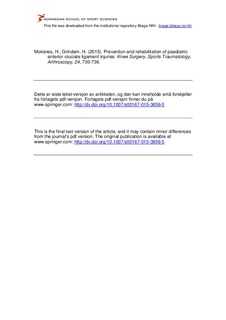| dc.contributor.author | Grindem, Hege | |
| dc.contributor.author | Moksnes, Håvard | |
| dc.date.accessioned | 2016-08-29T12:39:43Z | |
| dc.date.available | 2016-08-29T12:39:43Z | |
| dc.date.issued | 2015-11-14 | |
| dc.identifier.citation | Knee Surgery, Sports Traumatology, Arthroscopy. 2015, 24, 730-736 | nb_NO |
| dc.identifier.uri | http://hdl.handle.net/11250/2402505 | |
| dc.description | Dette er siste tekst-versjon av artikkelen, og den kan inneholde små forskjeller fra forlagets pdf-versjon. Forlagets pdf-versjon finner du på www.springer.com / This is the final text version of the article, and it may contain minor differences from the journal's pdf version. The original publication is available at www.springer.com | nb_NO |
| dc.description.abstract | Purpose:
To review the current knowledge on anterior cruciate ligament (ACL) injury prevention and ACL rehabilitation in individuals who have not yet reached musculoskeletal maturity.
Methods:
This is a narrative review based on a targeted and systematic literature search for paediatric ACL injury risk factors, injury prevention and rehabilitation.
Results:
The search strategies resulted in 119 hits on risk factor studies, 57 hits on prevention and 37 hits on rehabilitation. Modifiable risk factors for ACL injury are largely unknown in the paediatric population. ACL injury prevention using neuromuscular training is highly successful in the adolescent population, and existing injury prevention programmes are cost-effective. The efficacy of ACL injury prevention programmes in children is, however, investigated to a markedly lesser degree. Paediatric ACL injury rehabilitation is poorly described, although supervised active rehabilitation progressed through phases with functional milestones is generally encouraged.
Conclusion:
Although limited, current evidence supports implementation of injury prevention programmes in female football players from the age of 12. Supervised active rehabilitation where progression is guided by functional milestones is also advocated. Future identification of modifiable risk factors is needed to design prevention programmes for younger children. There is a need for international multicentre studies on treatment algorithms and rehabilitation to increase knowledge on the short- and long-term outcomes following existing algorithms. | nb_NO |
| dc.language.iso | eng | nb_NO |
| dc.publisher | Springer Verlag | nb_NO |
| dc.subject | anterior cruciate ligament | nb_NO |
| dc.subject | anterior cruciate ligament reconstruction | nb_NO |
| dc.subject | children | nb_NO |
| dc.subject | adolescents | nb_NO |
| dc.subject | knee function | nb_NO |
| dc.subject | rehabilitation | nb_NO |
| dc.title | Prevention and rehabilitation of paediatric anterior cruciate ligament injuries | nb_NO |
| dc.type | Journal article | nb_NO |
| dc.type | Peer reviewed | nb_NO |
| dc.subject.nsi | VDP::Medical disciplines: 700 | nb_NO |
| dc.source.journal | Knee Surgery, Sports Traumatology, Arthroscopy | nb_NO |
| dc.identifier.doi | 10.1007/s00167-015-3856-5 | |
| dc.description.localcode | Seksjon for idrettsmedisinske fag / Department of Sports Medicine | nb_NO |
